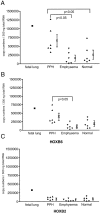HOX genes in human lung: altered expression in primary pulmonary hypertension and emphysema
- PMID: 11238043
- PMCID: PMC1850338
- DOI: 10.1016/S0002-9440(10)64042-4
HOX genes in human lung: altered expression in primary pulmonary hypertension and emphysema
Abstract
HOX genes belong to the large family of homeodomain genes that function as transcription factors. Animal studies indicate that they play an essential role in lung development. We investigated the expression pattern of HOX genes in human lung tissue by using microarray and degenerate reverse transcriptase-polymerase chain reaction survey techniques. HOX genes predominantly from the 3' end of clusters A and B were expressed in normal human adult lung and among them HOXA5 was the most abundant, followed by HOXB2 and HOXB6. In fetal (12 weeks old) and diseased lung specimens (emphysema, primary pulmonary hypertension) additional HOX genes from clusters C and D were expressed. Using in situ hybridization, transcripts for HOXA5 were predominantly found in alveolar septal and epithelial cells, both in normal and diseased lungs. A 2.5-fold increase in HOXA5 mRNA expression was demonstrated by quantitative reverse transcriptase-polymerase chain reaction in primary pulmonary hypertension lung specimens when compared to normal lung tissue. In conclusion, we demonstrate that HOX genes are selectively expressed in the human lung. Differences in the pattern of HOX gene expression exist among fetal, adult, and diseased lung specimens. The altered pattern of HOX gene expression may contribute to the development of pulmonary diseases.
Figures






References
-
- Mark M, Rijli FM, Chambon P: Homeobox genes in embryogenesis and pathogenesis. Pediatr Res 1997, 42:421-429 - PubMed
-
- Bogue CW, Lou LJ, Vasavada H, Wilson CM, Jacobs HC: Expression of Hoxb genes in the developing mouse foregut and lung. Am J Respir Cell Mol Biol 1996, 15:163-171 - PubMed
-
- Krumlauf R: Hox genes in vertebrate development. Cell 1994, 78:191-201 - PubMed
-
- Boncinelli E: Homeobox genes and disease. Curr Opin Genet Dev 1997, 7:331-337 - PubMed
-
- Stein S, Fritsch R, Lemaire L, Kessel M: Checklist: vertebrate homeobox genes. Mech Dev 1996, 55:91-108 - PubMed
Publication types
MeSH terms
Substances
Grants and funding
LinkOut - more resources
Full Text Sources
Other Literature Sources
Medical

